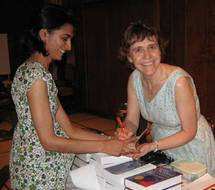Here's
a challenge for you: how many ways can the syllable that sounds like
“SEE” be spelled in English? Can you think of an example word to
illustrate each of those spellings? Keep thinking! All will be
revealed at the end of this article. Don't cheat by looking!
Because
English speakers have been such enthusiastic borrowers from other
languages throughout our history, our spelling is notoriously
non-phonetic. It causes grief to both native speakers and
second-language learners. But its sheer quirkiness has contributed to
what we can only call a “language as parlour game” phenomenon:
English speakers love to test their linguistic mettle (or is that
“metal”, or “meddle”, or “medal”?) in games like spelling
bees, and our many homophones make the language a fertile source for
punsters.
(How
are you doing on those “SEE” spellings? Are you up to 10 yet?
There are more!)
English
is a wacky language. Lunatic, even. Consider how many ways we can
write the sound “TOE”.
In
a sensible language, it would be written “to”. But no, not for
us. The digraph “to” is pronounced “TOE” in some words, but
when to
is
a word unto itself, it is pronounced “TOO”, not of course to be
confused with two
or
too,
dear me I am feeling faint.
pto ptomaine
tau taupe
teau plateau
teaux Saulteaux
tho Thomism
to potato
toa toad
toe toe
toh butoh
tot Pitot
tow tow
tto ditto
(12
spellings)
“Twelve
spellings,” you think, “But that's ridiculous!” (By the way,
how are those “SEE” spellings coming along? There are more than
twelve!)
Okay,
then. Or should I say, “Oqué!” Because, for the sound in “okay”
we have:
ca caber
cai caiman
cay decay
cca occasion
cei ceilidh
cha chaos
k KO
ka kaolin
kay okay
ke kea
kei keiretsu
key Keynesian
kka Akkadian
qa qadi
qué appliqué
que quesadilla
quet bouquet
(17
spellings)
Seventeen??!!
Surely there (not “their” or “they're”) can't be more for
“SEE”!
Think
again!
And
while you're mulling on that, let's talk about homophones some more.
Our old confusable friends affect/effect, desert/dessert, and
principal/principle are problems for all English speakers. But what
are homophones for Canadians are not necessarily homophones in other
varieties of English.
For
instance, khat
(an Arabian shrub the leaves of which are chewed as a stimulant),
cot,
and caught
are all pronounced the same in Canadian English but differently in
Southern Standard British English (where, what's more, caught
is
a homophone of court,
and khat
is a homophone of cart).
A
particularly interesting phenomenon occurs when a vowel precedes the
letter “r”. For most Canadians the words harry
and hairy
are
perfect homophones. Dictionaries from other countries would fail to
warn you about this.
It's
not just the vowels that are a problem, though. In North America we
tend to pronounce the letter “t” between two vowels or before a
syllabic “l” as “d”; hence it is possible to confuse tutor
and Tudor
or hurtle
and hurdle. I once was very confused by a discussion with a lawyer where he seemed to be referring to the company infringing someone else's trademark as a "traitor". "That's a bit harsh," I thought, till I realized the word he was using was "trader"!
You might think,
“Well, really, who would ever confuse tootsie
and Tutsi?”
But bear in mind that in a spelling bee, a contestant is given the
word orally out of context, so they have no way of knowing, when
they hear the sound “TOOT see” (there, I've just given you two
spellings of “SEE”!), whether piggies going to market or African
peoples are meant. There are many more homophones than you probably
suspect: we identified 1800 of them in the Canadian Oxford Dictionary.
To
keep you entertained while you're still working on your “SEE”
list, here are some other syllables in English with wildly variant
spellings:
The
choux is on the other foot:
choux choux
paste
sciu prosciutto
shoe shoe
shoo shoo
shu Shuswap
su sensual
tu punctual
xu sexual
(8
spellings)
Jai
thee to a nunnery:
ha'i Baha'i
hai Haida
hay
Haydnesque
hei heinie
heigh height
hi hi
hie hie
high high
hy hyacinth
jai jai
alai
(10
spellings, 11 if we also count chai in l'chaim)
Heaving
a sci:
ci cite
cy cyan
psi psi
psy psych
sai saiga
say sayonara
sci sciatic
scy scythe
si site
sig sign
sigh sigh
ssai assai
ssi Messiah
sy prophesy
xi xi
(15
spellings)
For
a small phoe:
fae faeces
fe febrile
fea feat
fee fee
ffee coffee
ffei caffeine
ffi graffiti
ffy taffy
fi fiasco
fie fief
fil fils
fille fille
de joie
filles filles
du roi
fit confit
fj fjord
foe foetus
fy salsify
ghie toughie
ghy roughy
phae nymphae
phe phenol
phee biographee
phi morphine
phoe phoebe
phy philosophy
(a
whopping 25 spellings)
But
“SEE” trumps them all. This is your last chance. Exhausted all
the possibilities you can think of?
There
are THIRTY-ONE different spellings of SEE” in English!
From
cey to coe:
c C-section
cae Caesar
ce cede
cea cease
cee Sadducee
cei receive
cey Ceylonese
ci calcium
cie policies
coe coelom
cy icy
sce scene
sci hyoscine
se sebum
sea sea
see see
sei seize
sey curtsey
si Tutsi
sie siege
sse Tennessean
ssee lessee
ssey odyssey
ssi lassi
ssie lassie
ssy sissy
sy hypocrisy
xe tuxedo
xi taxi
xie pixie
xy boxy
I
can only conclude that all of us who have to write English,
especially those of us who make our livings in the language
industries, deserve a meddle, dammit, I mean medal for putting up
with this chaos.
If you would be interested in taking my Rollicking Story of English course in January and February, please let me know (wordlady.barber@gmail.com). It would be a weekday morning or afternoon in Toronto (let me know which days and times suit you best). 9 weeks, $280.







